Comprehensive Analysis of Marks & Spencer: Strategy & Leadership
VerifiedAdded on 2023/06/14
|11
|3815
|164
Report
AI Summary
This report provides a comprehensive analysis of Marks and Spencer (M&S), a British multinational retailer, focusing on its business context through internal and external environmental factors. It includes a SWOT analysis highlighting M&S's strengths (market presence, brand image) and weaknesses (ineffective supply chain, reliance on manual operations), as well as opportunities (online presence, new segments) and threats (competitors, financial issues). The PESTLE analysis examines political, economic, social, technological, legal, and environmental factors affecting M&S, including the impact of Brexit and COVID-19. The report also evaluates suitable leadership styles for meeting objectives in a changing business environment and critically assesses M&S's corporate social responsibilities, emphasizing the importance of adapting to market dynamics and stakeholder expectations. Desklib offers this report and many other solved assignments for students.
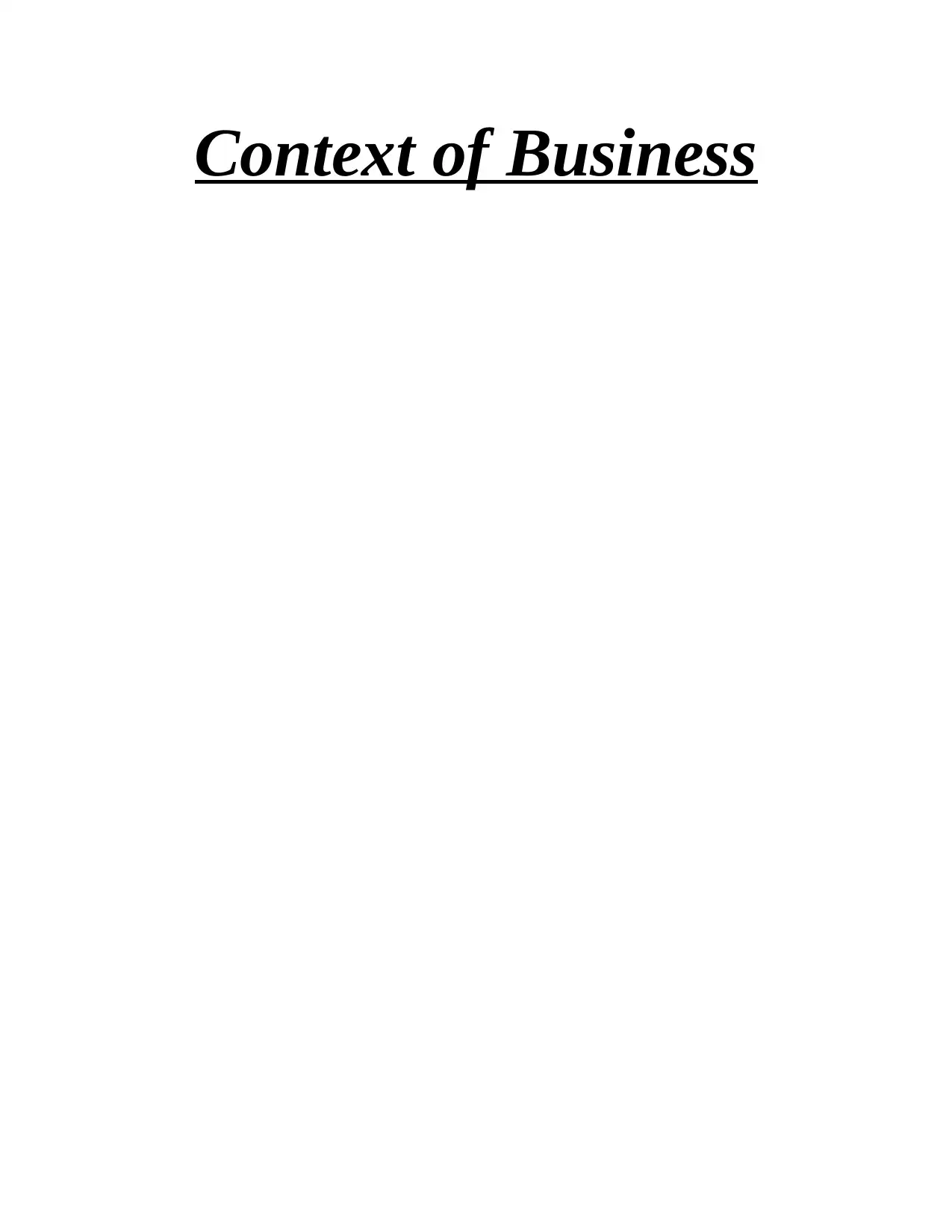
Context of Business
Paraphrase This Document
Need a fresh take? Get an instant paraphrase of this document with our AI Paraphraser
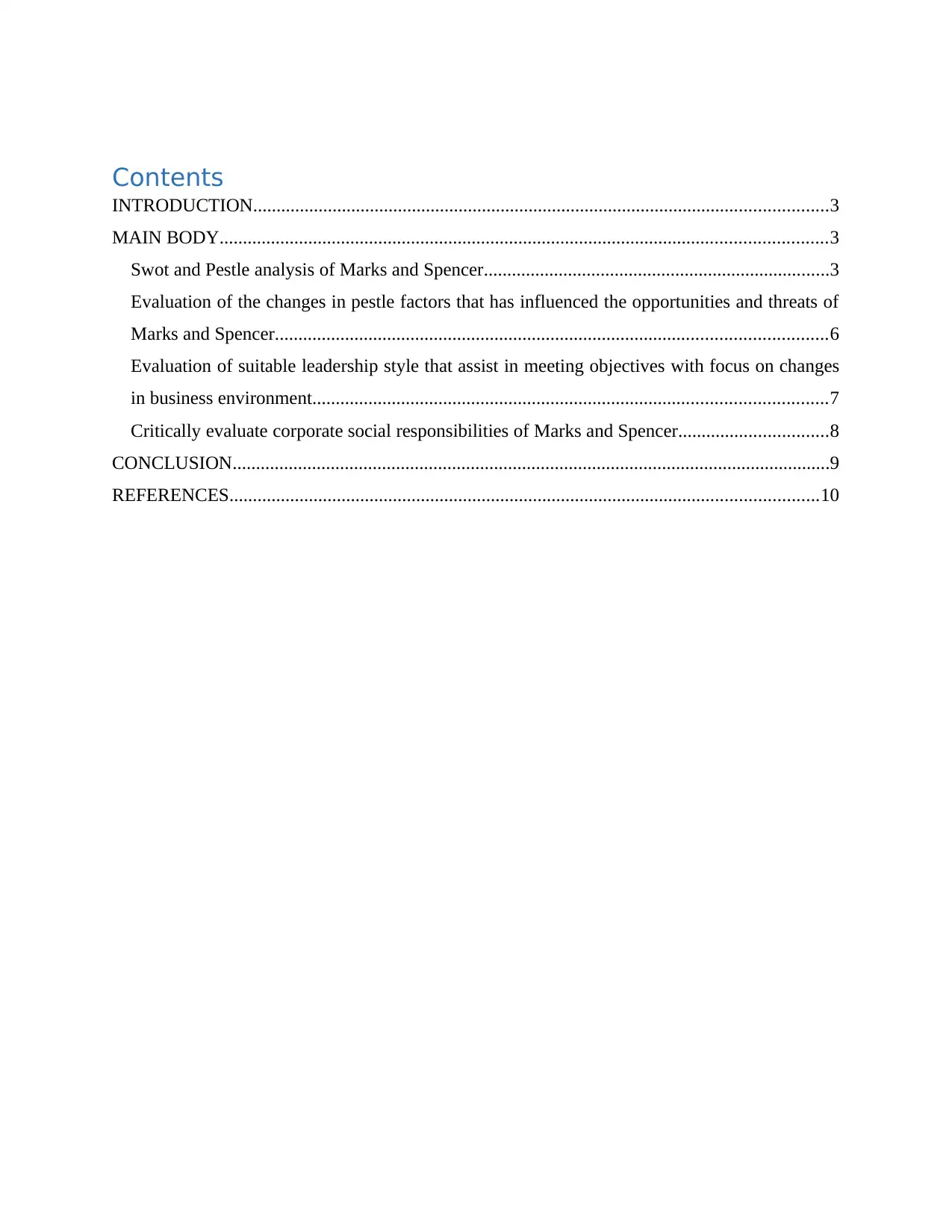
Contents
INTRODUCTION...........................................................................................................................3
MAIN BODY..................................................................................................................................3
Swot and Pestle analysis of Marks and Spencer..........................................................................3
Evaluation of the changes in pestle factors that has influenced the opportunities and threats of
Marks and Spencer......................................................................................................................6
Evaluation of suitable leadership style that assist in meeting objectives with focus on changes
in business environment..............................................................................................................7
Critically evaluate corporate social responsibilities of Marks and Spencer................................8
CONCLUSION................................................................................................................................9
REFERENCES..............................................................................................................................10
INTRODUCTION...........................................................................................................................3
MAIN BODY..................................................................................................................................3
Swot and Pestle analysis of Marks and Spencer..........................................................................3
Evaluation of the changes in pestle factors that has influenced the opportunities and threats of
Marks and Spencer......................................................................................................................6
Evaluation of suitable leadership style that assist in meeting objectives with focus on changes
in business environment..............................................................................................................7
Critically evaluate corporate social responsibilities of Marks and Spencer................................8
CONCLUSION................................................................................................................................9
REFERENCES..............................................................................................................................10

INTRODUCTION
Business context encircle knowledge and understanding of different factors which influence
businesses on various ways. In addition to this, it consists of how decisions are made and what
organisations is trying to attain. It is important for a company to monitor and trach its
performance and objectives which assist in developing a purpose-driven approach (Alberdi,
2018). It is vital for a company to conduct internal and external analysis as it help in maintaining
performance and to achieve objective as well. In the present study, Marks and Spencer is taken
into consideration. It is a British multinational retailer which was established in 1884 and
headquartered in London, United Kingdom. The company has around 1450 stores globally that
shows it has high market share and presence. The report will cover internal and external analysis
of chosen company along with how the factors of Pestle impact on opportunities as well as
threats of organisation. In addition to this, there is a discussion about different leadership styles
and Corporate social responsibilities associated to organisation.
MAIN BODY
Swot and Pestle analysis of Marks and Spencer
Swot analysis:
It is defined as a strategic planning technique which allow a company to analyse its
strength and opportunities. Along with this, it provides an in-depth knowledge about the threats
and weaknesses due to which company is able to develop strategies and decline the level of
weaknesses and threats in an effective manner. With the help of Swot analysis, a company is able
to identify the level of competition prevail in market and also evaluate the factors affect on their
business operations. Below is the SWOT analysis of Marks and Spencer:
Strengths: Market presence: One of the major strength of Marks and Spencer is its market presence
as it has around 1460 stores globally. This help company to increase its customer base
level and gain high profitability as well. Brand image: Another strength is its brand image, Marks and Spencer focuses on
fulfilling the requirements of customers and ensures that issues of customers is resolved
timely (Alexandridis, 2021). This help in developing positive mind-set of customers
towards the brand and retain them for longer time period.
Business context encircle knowledge and understanding of different factors which influence
businesses on various ways. In addition to this, it consists of how decisions are made and what
organisations is trying to attain. It is important for a company to monitor and trach its
performance and objectives which assist in developing a purpose-driven approach (Alberdi,
2018). It is vital for a company to conduct internal and external analysis as it help in maintaining
performance and to achieve objective as well. In the present study, Marks and Spencer is taken
into consideration. It is a British multinational retailer which was established in 1884 and
headquartered in London, United Kingdom. The company has around 1450 stores globally that
shows it has high market share and presence. The report will cover internal and external analysis
of chosen company along with how the factors of Pestle impact on opportunities as well as
threats of organisation. In addition to this, there is a discussion about different leadership styles
and Corporate social responsibilities associated to organisation.
MAIN BODY
Swot and Pestle analysis of Marks and Spencer
Swot analysis:
It is defined as a strategic planning technique which allow a company to analyse its
strength and opportunities. Along with this, it provides an in-depth knowledge about the threats
and weaknesses due to which company is able to develop strategies and decline the level of
weaknesses and threats in an effective manner. With the help of Swot analysis, a company is able
to identify the level of competition prevail in market and also evaluate the factors affect on their
business operations. Below is the SWOT analysis of Marks and Spencer:
Strengths: Market presence: One of the major strength of Marks and Spencer is its market presence
as it has around 1460 stores globally. This help company to increase its customer base
level and gain high profitability as well. Brand image: Another strength is its brand image, Marks and Spencer focuses on
fulfilling the requirements of customers and ensures that issues of customers is resolved
timely (Alexandridis, 2021). This help in developing positive mind-set of customers
towards the brand and retain them for longer time period.
⊘ This is a preview!⊘
Do you want full access?
Subscribe today to unlock all pages.

Trusted by 1+ million students worldwide
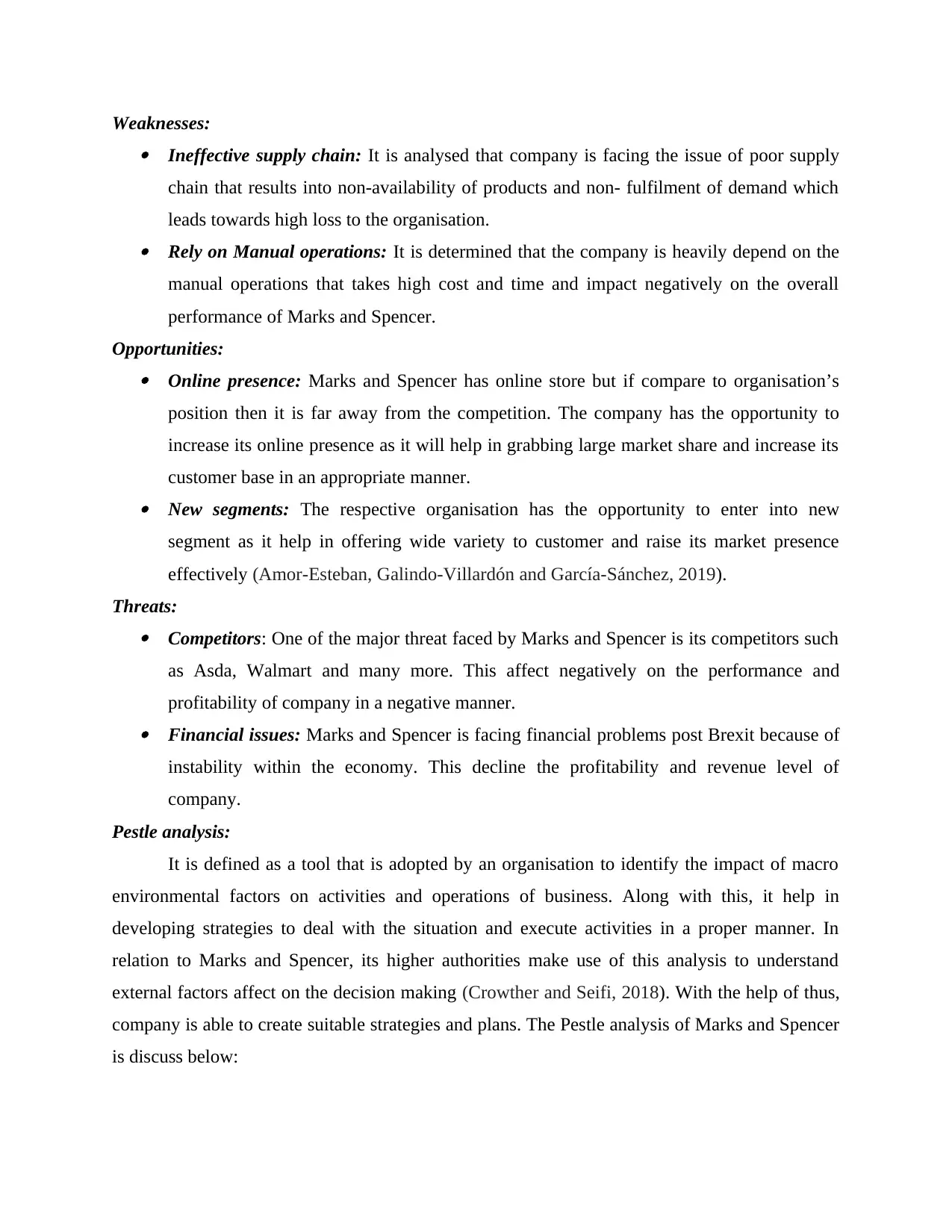
Weaknesses: Ineffective supply chain: It is analysed that company is facing the issue of poor supply
chain that results into non-availability of products and non- fulfilment of demand which
leads towards high loss to the organisation. Rely on Manual operations: It is determined that the company is heavily depend on the
manual operations that takes high cost and time and impact negatively on the overall
performance of Marks and Spencer.
Opportunities: Online presence: Marks and Spencer has online store but if compare to organisation’s
position then it is far away from the competition. The company has the opportunity to
increase its online presence as it will help in grabbing large market share and increase its
customer base in an appropriate manner. New segments: The respective organisation has the opportunity to enter into new
segment as it help in offering wide variety to customer and raise its market presence
effectively (Amor-Esteban, Galindo-Villardón and García-Sánchez, 2019).
Threats: Competitors: One of the major threat faced by Marks and Spencer is its competitors such
as Asda, Walmart and many more. This affect negatively on the performance and
profitability of company in a negative manner. Financial issues: Marks and Spencer is facing financial problems post Brexit because of
instability within the economy. This decline the profitability and revenue level of
company.
Pestle analysis:
It is defined as a tool that is adopted by an organisation to identify the impact of macro
environmental factors on activities and operations of business. Along with this, it help in
developing strategies to deal with the situation and execute activities in a proper manner. In
relation to Marks and Spencer, its higher authorities make use of this analysis to understand
external factors affect on the decision making (Crowther and Seifi, 2018). With the help of thus,
company is able to create suitable strategies and plans. The Pestle analysis of Marks and Spencer
is discuss below:
chain that results into non-availability of products and non- fulfilment of demand which
leads towards high loss to the organisation. Rely on Manual operations: It is determined that the company is heavily depend on the
manual operations that takes high cost and time and impact negatively on the overall
performance of Marks and Spencer.
Opportunities: Online presence: Marks and Spencer has online store but if compare to organisation’s
position then it is far away from the competition. The company has the opportunity to
increase its online presence as it will help in grabbing large market share and increase its
customer base in an appropriate manner. New segments: The respective organisation has the opportunity to enter into new
segment as it help in offering wide variety to customer and raise its market presence
effectively (Amor-Esteban, Galindo-Villardón and García-Sánchez, 2019).
Threats: Competitors: One of the major threat faced by Marks and Spencer is its competitors such
as Asda, Walmart and many more. This affect negatively on the performance and
profitability of company in a negative manner. Financial issues: Marks and Spencer is facing financial problems post Brexit because of
instability within the economy. This decline the profitability and revenue level of
company.
Pestle analysis:
It is defined as a tool that is adopted by an organisation to identify the impact of macro
environmental factors on activities and operations of business. Along with this, it help in
developing strategies to deal with the situation and execute activities in a proper manner. In
relation to Marks and Spencer, its higher authorities make use of this analysis to understand
external factors affect on the decision making (Crowther and Seifi, 2018). With the help of thus,
company is able to create suitable strategies and plans. The Pestle analysis of Marks and Spencer
is discuss below:
Paraphrase This Document
Need a fresh take? Get an instant paraphrase of this document with our AI Paraphraser
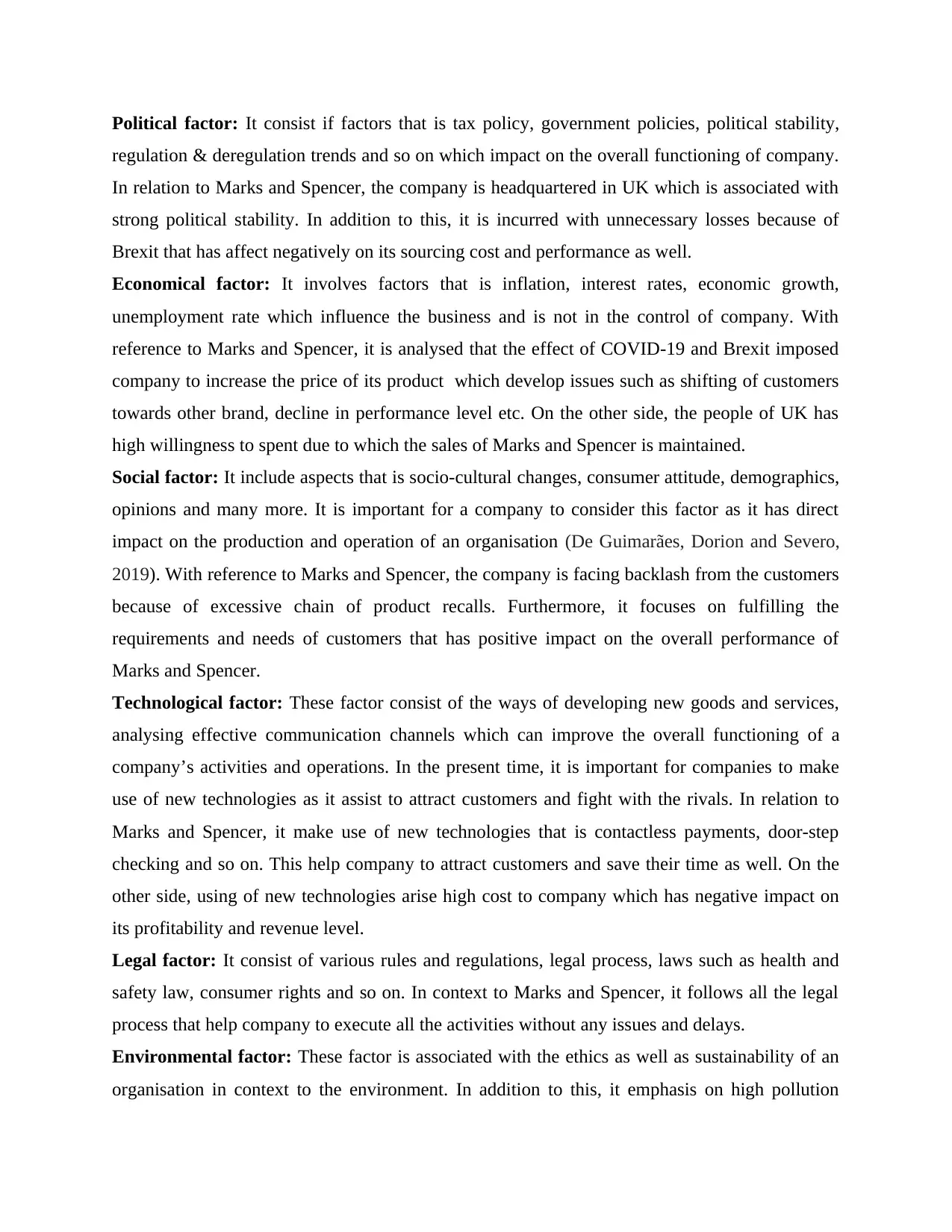
Political factor: It consist if factors that is tax policy, government policies, political stability,
regulation & deregulation trends and so on which impact on the overall functioning of company.
In relation to Marks and Spencer, the company is headquartered in UK which is associated with
strong political stability. In addition to this, it is incurred with unnecessary losses because of
Brexit that has affect negatively on its sourcing cost and performance as well.
Economical factor: It involves factors that is inflation, interest rates, economic growth,
unemployment rate which influence the business and is not in the control of company. With
reference to Marks and Spencer, it is analysed that the effect of COVID-19 and Brexit imposed
company to increase the price of its product which develop issues such as shifting of customers
towards other brand, decline in performance level etc. On the other side, the people of UK has
high willingness to spent due to which the sales of Marks and Spencer is maintained.
Social factor: It include aspects that is socio-cultural changes, consumer attitude, demographics,
opinions and many more. It is important for a company to consider this factor as it has direct
impact on the production and operation of an organisation (De Guimarães, Dorion and Severo,
2019). With reference to Marks and Spencer, the company is facing backlash from the customers
because of excessive chain of product recalls. Furthermore, it focuses on fulfilling the
requirements and needs of customers that has positive impact on the overall performance of
Marks and Spencer.
Technological factor: These factor consist of the ways of developing new goods and services,
analysing effective communication channels which can improve the overall functioning of a
company’s activities and operations. In the present time, it is important for companies to make
use of new technologies as it assist to attract customers and fight with the rivals. In relation to
Marks and Spencer, it make use of new technologies that is contactless payments, door-step
checking and so on. This help company to attract customers and save their time as well. On the
other side, using of new technologies arise high cost to company which has negative impact on
its profitability and revenue level.
Legal factor: It consist of various rules and regulations, legal process, laws such as health and
safety law, consumer rights and so on. In context to Marks and Spencer, it follows all the legal
process that help company to execute all the activities without any issues and delays.
Environmental factor: These factor is associated with the ethics as well as sustainability of an
organisation in context to the environment. In addition to this, it emphasis on high pollution
regulation & deregulation trends and so on which impact on the overall functioning of company.
In relation to Marks and Spencer, the company is headquartered in UK which is associated with
strong political stability. In addition to this, it is incurred with unnecessary losses because of
Brexit that has affect negatively on its sourcing cost and performance as well.
Economical factor: It involves factors that is inflation, interest rates, economic growth,
unemployment rate which influence the business and is not in the control of company. With
reference to Marks and Spencer, it is analysed that the effect of COVID-19 and Brexit imposed
company to increase the price of its product which develop issues such as shifting of customers
towards other brand, decline in performance level etc. On the other side, the people of UK has
high willingness to spent due to which the sales of Marks and Spencer is maintained.
Social factor: It include aspects that is socio-cultural changes, consumer attitude, demographics,
opinions and many more. It is important for a company to consider this factor as it has direct
impact on the production and operation of an organisation (De Guimarães, Dorion and Severo,
2019). With reference to Marks and Spencer, the company is facing backlash from the customers
because of excessive chain of product recalls. Furthermore, it focuses on fulfilling the
requirements and needs of customers that has positive impact on the overall performance of
Marks and Spencer.
Technological factor: These factor consist of the ways of developing new goods and services,
analysing effective communication channels which can improve the overall functioning of a
company’s activities and operations. In the present time, it is important for companies to make
use of new technologies as it assist to attract customers and fight with the rivals. In relation to
Marks and Spencer, it make use of new technologies that is contactless payments, door-step
checking and so on. This help company to attract customers and save their time as well. On the
other side, using of new technologies arise high cost to company which has negative impact on
its profitability and revenue level.
Legal factor: It consist of various rules and regulations, legal process, laws such as health and
safety law, consumer rights and so on. In context to Marks and Spencer, it follows all the legal
process that help company to execute all the activities without any issues and delays.
Environmental factor: These factor is associated with the ethics as well as sustainability of an
organisation in context to the environment. In addition to this, it emphasis on high pollution
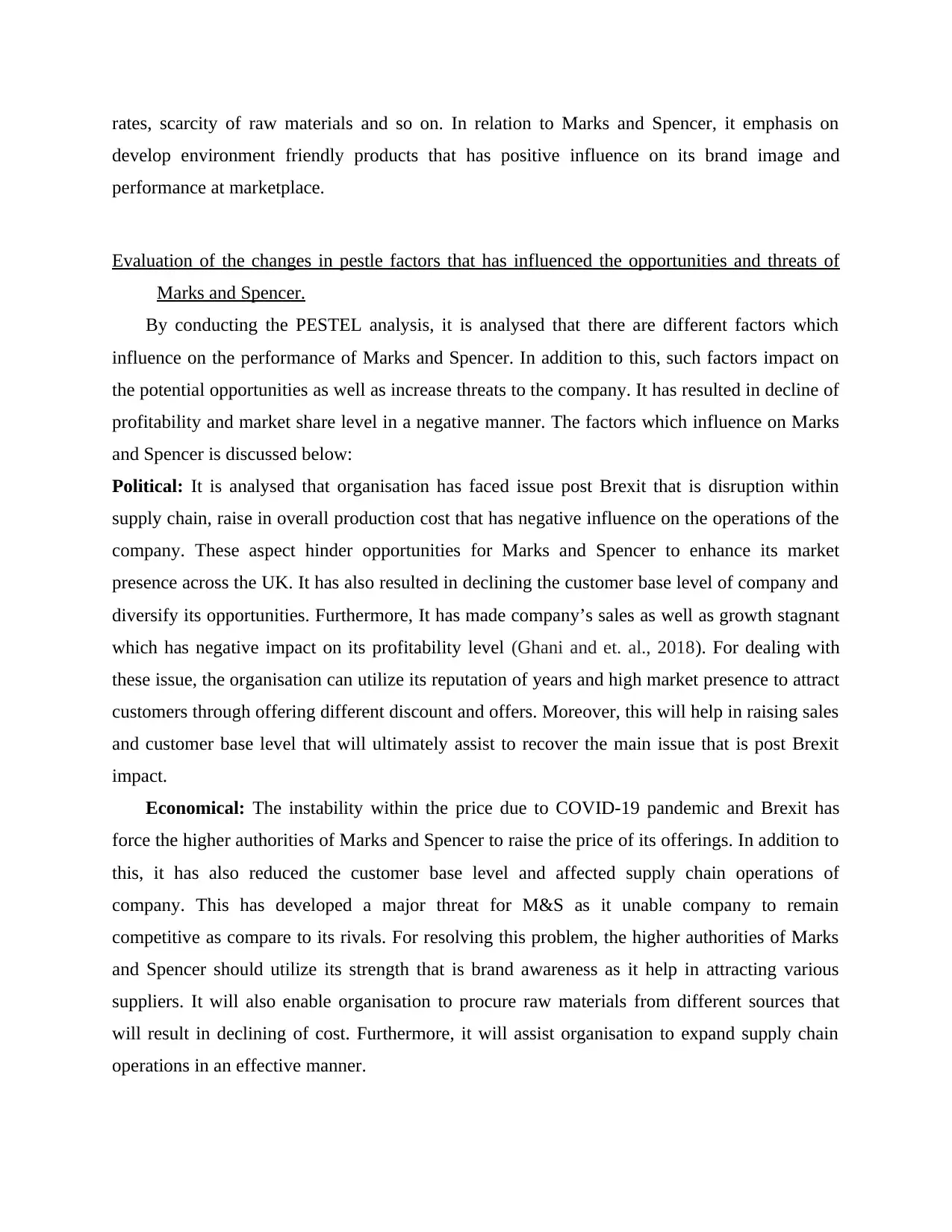
rates, scarcity of raw materials and so on. In relation to Marks and Spencer, it emphasis on
develop environment friendly products that has positive influence on its brand image and
performance at marketplace.
Evaluation of the changes in pestle factors that has influenced the opportunities and threats of
Marks and Spencer.
By conducting the PESTEL analysis, it is analysed that there are different factors which
influence on the performance of Marks and Spencer. In addition to this, such factors impact on
the potential opportunities as well as increase threats to the company. It has resulted in decline of
profitability and market share level in a negative manner. The factors which influence on Marks
and Spencer is discussed below:
Political: It is analysed that organisation has faced issue post Brexit that is disruption within
supply chain, raise in overall production cost that has negative influence on the operations of the
company. These aspect hinder opportunities for Marks and Spencer to enhance its market
presence across the UK. It has also resulted in declining the customer base level of company and
diversify its opportunities. Furthermore, It has made company’s sales as well as growth stagnant
which has negative impact on its profitability level (Ghani and et. al., 2018). For dealing with
these issue, the organisation can utilize its reputation of years and high market presence to attract
customers through offering different discount and offers. Moreover, this will help in raising sales
and customer base level that will ultimately assist to recover the main issue that is post Brexit
impact.
Economical: The instability within the price due to COVID-19 pandemic and Brexit has
force the higher authorities of Marks and Spencer to raise the price of its offerings. In addition to
this, it has also reduced the customer base level and affected supply chain operations of
company. This has developed a major threat for M&S as it unable company to remain
competitive as compare to its rivals. For resolving this problem, the higher authorities of Marks
and Spencer should utilize its strength that is brand awareness as it help in attracting various
suppliers. It will also enable organisation to procure raw materials from different sources that
will result in declining of cost. Furthermore, it will assist organisation to expand supply chain
operations in an effective manner.
develop environment friendly products that has positive influence on its brand image and
performance at marketplace.
Evaluation of the changes in pestle factors that has influenced the opportunities and threats of
Marks and Spencer.
By conducting the PESTEL analysis, it is analysed that there are different factors which
influence on the performance of Marks and Spencer. In addition to this, such factors impact on
the potential opportunities as well as increase threats to the company. It has resulted in decline of
profitability and market share level in a negative manner. The factors which influence on Marks
and Spencer is discussed below:
Political: It is analysed that organisation has faced issue post Brexit that is disruption within
supply chain, raise in overall production cost that has negative influence on the operations of the
company. These aspect hinder opportunities for Marks and Spencer to enhance its market
presence across the UK. It has also resulted in declining the customer base level of company and
diversify its opportunities. Furthermore, It has made company’s sales as well as growth stagnant
which has negative impact on its profitability level (Ghani and et. al., 2018). For dealing with
these issue, the organisation can utilize its reputation of years and high market presence to attract
customers through offering different discount and offers. Moreover, this will help in raising sales
and customer base level that will ultimately assist to recover the main issue that is post Brexit
impact.
Economical: The instability within the price due to COVID-19 pandemic and Brexit has
force the higher authorities of Marks and Spencer to raise the price of its offerings. In addition to
this, it has also reduced the customer base level and affected supply chain operations of
company. This has developed a major threat for M&S as it unable company to remain
competitive as compare to its rivals. For resolving this problem, the higher authorities of Marks
and Spencer should utilize its strength that is brand awareness as it help in attracting various
suppliers. It will also enable organisation to procure raw materials from different sources that
will result in declining of cost. Furthermore, it will assist organisation to expand supply chain
operations in an effective manner.
⊘ This is a preview!⊘
Do you want full access?
Subscribe today to unlock all pages.

Trusted by 1+ million students worldwide
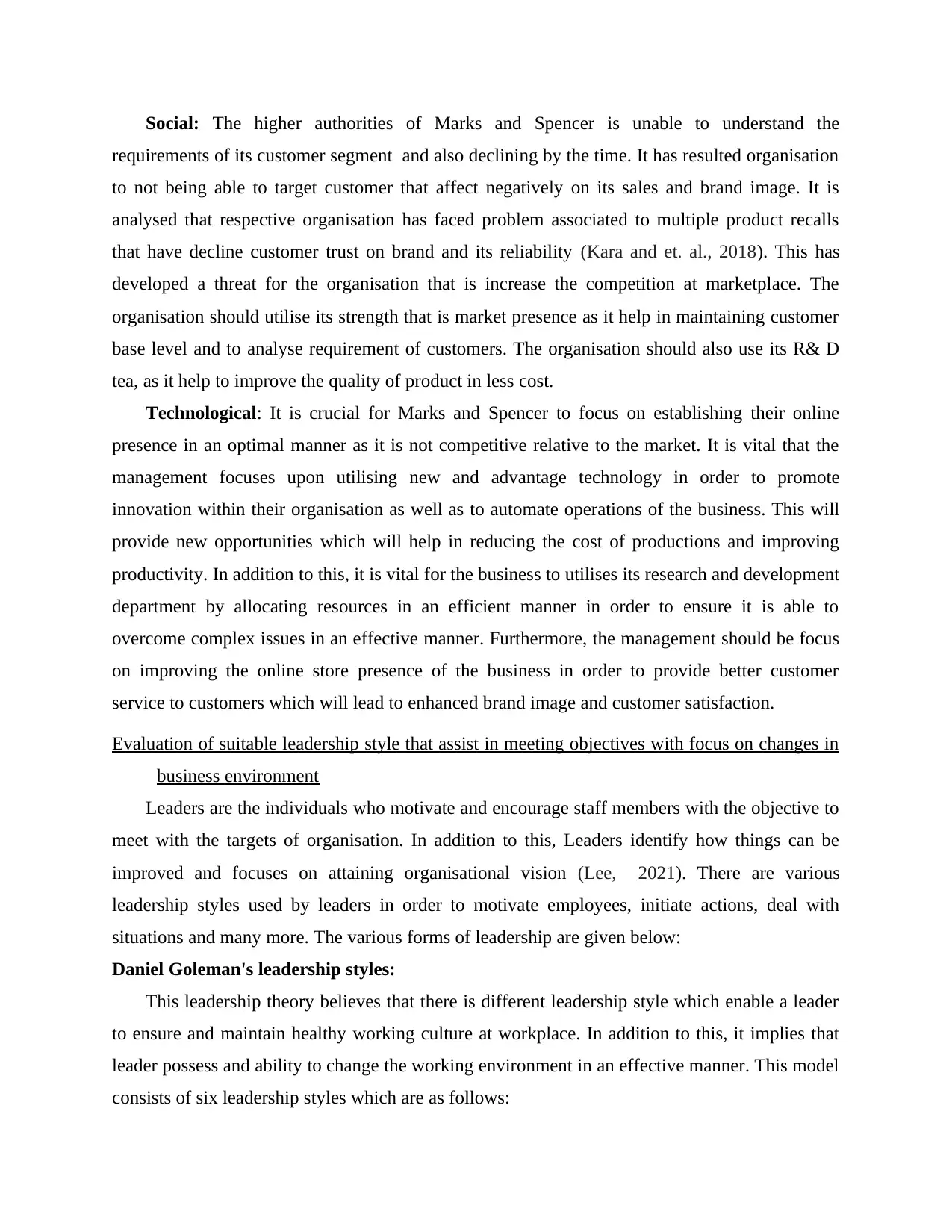
Social: The higher authorities of Marks and Spencer is unable to understand the
requirements of its customer segment and also declining by the time. It has resulted organisation
to not being able to target customer that affect negatively on its sales and brand image. It is
analysed that respective organisation has faced problem associated to multiple product recalls
that have decline customer trust on brand and its reliability (Kara and et. al., 2018). This has
developed a threat for the organisation that is increase the competition at marketplace. The
organisation should utilise its strength that is market presence as it help in maintaining customer
base level and to analyse requirement of customers. The organisation should also use its R& D
tea, as it help to improve the quality of product in less cost.
Technological: It is crucial for Marks and Spencer to focus on establishing their online
presence in an optimal manner as it is not competitive relative to the market. It is vital that the
management focuses upon utilising new and advantage technology in order to promote
innovation within their organisation as well as to automate operations of the business. This will
provide new opportunities which will help in reducing the cost of productions and improving
productivity. In addition to this, it is vital for the business to utilises its research and development
department by allocating resources in an efficient manner in order to ensure it is able to
overcome complex issues in an effective manner. Furthermore, the management should be focus
on improving the online store presence of the business in order to provide better customer
service to customers which will lead to enhanced brand image and customer satisfaction.
Evaluation of suitable leadership style that assist in meeting objectives with focus on changes in
business environment
Leaders are the individuals who motivate and encourage staff members with the objective to
meet with the targets of organisation. In addition to this, Leaders identify how things can be
improved and focuses on attaining organisational vision (Lee, 2021). There are various
leadership styles used by leaders in order to motivate employees, initiate actions, deal with
situations and many more. The various forms of leadership are given below:
Daniel Goleman's leadership styles:
This leadership theory believes that there is different leadership style which enable a leader
to ensure and maintain healthy working culture at workplace. In addition to this, it implies that
leader possess and ability to change the working environment in an effective manner. This model
consists of six leadership styles which are as follows:
requirements of its customer segment and also declining by the time. It has resulted organisation
to not being able to target customer that affect negatively on its sales and brand image. It is
analysed that respective organisation has faced problem associated to multiple product recalls
that have decline customer trust on brand and its reliability (Kara and et. al., 2018). This has
developed a threat for the organisation that is increase the competition at marketplace. The
organisation should utilise its strength that is market presence as it help in maintaining customer
base level and to analyse requirement of customers. The organisation should also use its R& D
tea, as it help to improve the quality of product in less cost.
Technological: It is crucial for Marks and Spencer to focus on establishing their online
presence in an optimal manner as it is not competitive relative to the market. It is vital that the
management focuses upon utilising new and advantage technology in order to promote
innovation within their organisation as well as to automate operations of the business. This will
provide new opportunities which will help in reducing the cost of productions and improving
productivity. In addition to this, it is vital for the business to utilises its research and development
department by allocating resources in an efficient manner in order to ensure it is able to
overcome complex issues in an effective manner. Furthermore, the management should be focus
on improving the online store presence of the business in order to provide better customer
service to customers which will lead to enhanced brand image and customer satisfaction.
Evaluation of suitable leadership style that assist in meeting objectives with focus on changes in
business environment
Leaders are the individuals who motivate and encourage staff members with the objective to
meet with the targets of organisation. In addition to this, Leaders identify how things can be
improved and focuses on attaining organisational vision (Lee, 2021). There are various
leadership styles used by leaders in order to motivate employees, initiate actions, deal with
situations and many more. The various forms of leadership are given below:
Daniel Goleman's leadership styles:
This leadership theory believes that there is different leadership style which enable a leader
to ensure and maintain healthy working culture at workplace. In addition to this, it implies that
leader possess and ability to change the working environment in an effective manner. This model
consists of six leadership styles which are as follows:
Paraphrase This Document
Need a fresh take? Get an instant paraphrase of this document with our AI Paraphraser
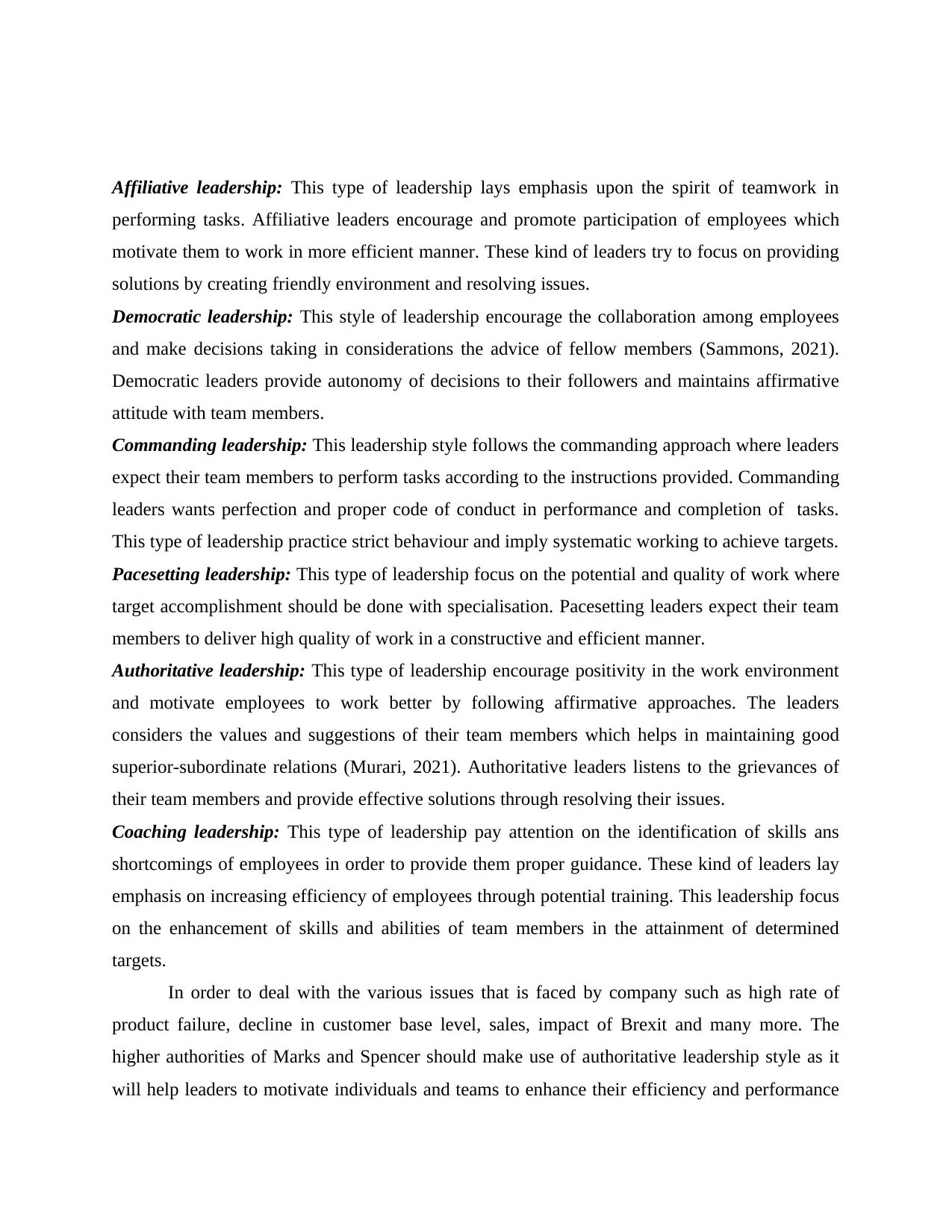
Affiliative leadership: This type of leadership lays emphasis upon the spirit of teamwork in
performing tasks. Affiliative leaders encourage and promote participation of employees which
motivate them to work in more efficient manner. These kind of leaders try to focus on providing
solutions by creating friendly environment and resolving issues.
Democratic leadership: This style of leadership encourage the collaboration among employees
and make decisions taking in considerations the advice of fellow members (Sammons, 2021).
Democratic leaders provide autonomy of decisions to their followers and maintains affirmative
attitude with team members.
Commanding leadership: This leadership style follows the commanding approach where leaders
expect their team members to perform tasks according to the instructions provided. Commanding
leaders wants perfection and proper code of conduct in performance and completion of tasks.
This type of leadership practice strict behaviour and imply systematic working to achieve targets.
Pacesetting leadership: This type of leadership focus on the potential and quality of work where
target accomplishment should be done with specialisation. Pacesetting leaders expect their team
members to deliver high quality of work in a constructive and efficient manner.
Authoritative leadership: This type of leadership encourage positivity in the work environment
and motivate employees to work better by following affirmative approaches. The leaders
considers the values and suggestions of their team members which helps in maintaining good
superior-subordinate relations (Murari, 2021). Authoritative leaders listens to the grievances of
their team members and provide effective solutions through resolving their issues.
Coaching leadership: This type of leadership pay attention on the identification of skills ans
shortcomings of employees in order to provide them proper guidance. These kind of leaders lay
emphasis on increasing efficiency of employees through potential training. This leadership focus
on the enhancement of skills and abilities of team members in the attainment of determined
targets.
In order to deal with the various issues that is faced by company such as high rate of
product failure, decline in customer base level, sales, impact of Brexit and many more. The
higher authorities of Marks and Spencer should make use of authoritative leadership style as it
will help leaders to motivate individuals and teams to enhance their efficiency and performance
performing tasks. Affiliative leaders encourage and promote participation of employees which
motivate them to work in more efficient manner. These kind of leaders try to focus on providing
solutions by creating friendly environment and resolving issues.
Democratic leadership: This style of leadership encourage the collaboration among employees
and make decisions taking in considerations the advice of fellow members (Sammons, 2021).
Democratic leaders provide autonomy of decisions to their followers and maintains affirmative
attitude with team members.
Commanding leadership: This leadership style follows the commanding approach where leaders
expect their team members to perform tasks according to the instructions provided. Commanding
leaders wants perfection and proper code of conduct in performance and completion of tasks.
This type of leadership practice strict behaviour and imply systematic working to achieve targets.
Pacesetting leadership: This type of leadership focus on the potential and quality of work where
target accomplishment should be done with specialisation. Pacesetting leaders expect their team
members to deliver high quality of work in a constructive and efficient manner.
Authoritative leadership: This type of leadership encourage positivity in the work environment
and motivate employees to work better by following affirmative approaches. The leaders
considers the values and suggestions of their team members which helps in maintaining good
superior-subordinate relations (Murari, 2021). Authoritative leaders listens to the grievances of
their team members and provide effective solutions through resolving their issues.
Coaching leadership: This type of leadership pay attention on the identification of skills ans
shortcomings of employees in order to provide them proper guidance. These kind of leaders lay
emphasis on increasing efficiency of employees through potential training. This leadership focus
on the enhancement of skills and abilities of team members in the attainment of determined
targets.
In order to deal with the various issues that is faced by company such as high rate of
product failure, decline in customer base level, sales, impact of Brexit and many more. The
higher authorities of Marks and Spencer should make use of authoritative leadership style as it
will help leaders to motivate individuals and teams to enhance their efficiency and performance
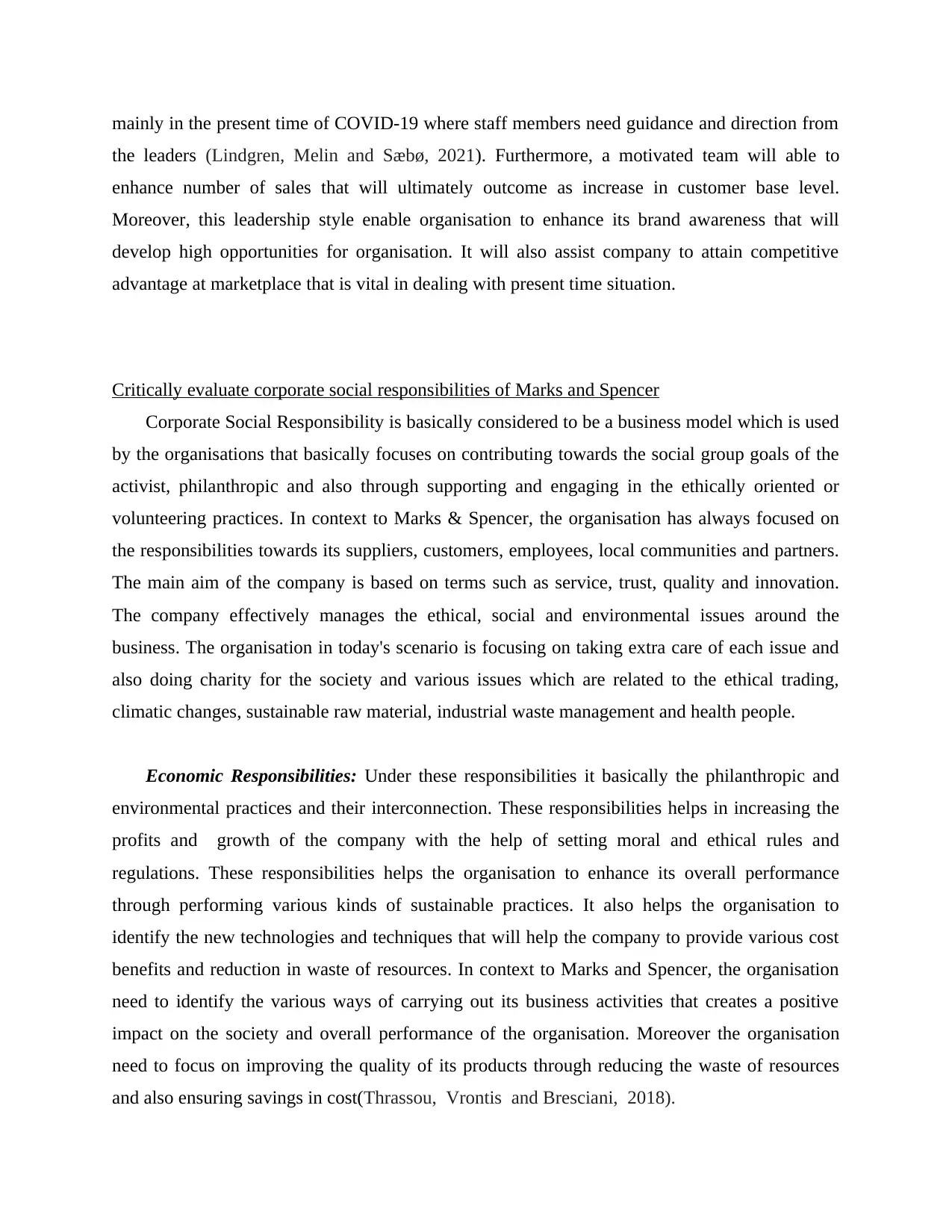
mainly in the present time of COVID-19 where staff members need guidance and direction from
the leaders (Lindgren, Melin and Sæbø, 2021). Furthermore, a motivated team will able to
enhance number of sales that will ultimately outcome as increase in customer base level.
Moreover, this leadership style enable organisation to enhance its brand awareness that will
develop high opportunities for organisation. It will also assist company to attain competitive
advantage at marketplace that is vital in dealing with present time situation.
Critically evaluate corporate social responsibilities of Marks and Spencer
Corporate Social Responsibility is basically considered to be a business model which is used
by the organisations that basically focuses on contributing towards the social group goals of the
activist, philanthropic and also through supporting and engaging in the ethically oriented or
volunteering practices. In context to Marks & Spencer, the organisation has always focused on
the responsibilities towards its suppliers, customers, employees, local communities and partners.
The main aim of the company is based on terms such as service, trust, quality and innovation.
The company effectively manages the ethical, social and environmental issues around the
business. The organisation in today's scenario is focusing on taking extra care of each issue and
also doing charity for the society and various issues which are related to the ethical trading,
climatic changes, sustainable raw material, industrial waste management and health people.
Economic Responsibilities: Under these responsibilities it basically the philanthropic and
environmental practices and their interconnection. These responsibilities helps in increasing the
profits and growth of the company with the help of setting moral and ethical rules and
regulations. These responsibilities helps the organisation to enhance its overall performance
through performing various kinds of sustainable practices. It also helps the organisation to
identify the new technologies and techniques that will help the company to provide various cost
benefits and reduction in waste of resources. In context to Marks and Spencer, the organisation
need to identify the various ways of carrying out its business activities that creates a positive
impact on the society and overall performance of the organisation. Moreover the organisation
need to focus on improving the quality of its products through reducing the waste of resources
and also ensuring savings in cost(Thrassou, Vrontis and Bresciani, 2018).
the leaders (Lindgren, Melin and Sæbø, 2021). Furthermore, a motivated team will able to
enhance number of sales that will ultimately outcome as increase in customer base level.
Moreover, this leadership style enable organisation to enhance its brand awareness that will
develop high opportunities for organisation. It will also assist company to attain competitive
advantage at marketplace that is vital in dealing with present time situation.
Critically evaluate corporate social responsibilities of Marks and Spencer
Corporate Social Responsibility is basically considered to be a business model which is used
by the organisations that basically focuses on contributing towards the social group goals of the
activist, philanthropic and also through supporting and engaging in the ethically oriented or
volunteering practices. In context to Marks & Spencer, the organisation has always focused on
the responsibilities towards its suppliers, customers, employees, local communities and partners.
The main aim of the company is based on terms such as service, trust, quality and innovation.
The company effectively manages the ethical, social and environmental issues around the
business. The organisation in today's scenario is focusing on taking extra care of each issue and
also doing charity for the society and various issues which are related to the ethical trading,
climatic changes, sustainable raw material, industrial waste management and health people.
Economic Responsibilities: Under these responsibilities it basically the philanthropic and
environmental practices and their interconnection. These responsibilities helps in increasing the
profits and growth of the company with the help of setting moral and ethical rules and
regulations. These responsibilities helps the organisation to enhance its overall performance
through performing various kinds of sustainable practices. It also helps the organisation to
identify the new technologies and techniques that will help the company to provide various cost
benefits and reduction in waste of resources. In context to Marks and Spencer, the organisation
need to identify the various ways of carrying out its business activities that creates a positive
impact on the society and overall performance of the organisation. Moreover the organisation
need to focus on improving the quality of its products through reducing the waste of resources
and also ensuring savings in cost(Thrassou, Vrontis and Bresciani, 2018).
⊘ This is a preview!⊘
Do you want full access?
Subscribe today to unlock all pages.

Trusted by 1+ million students worldwide
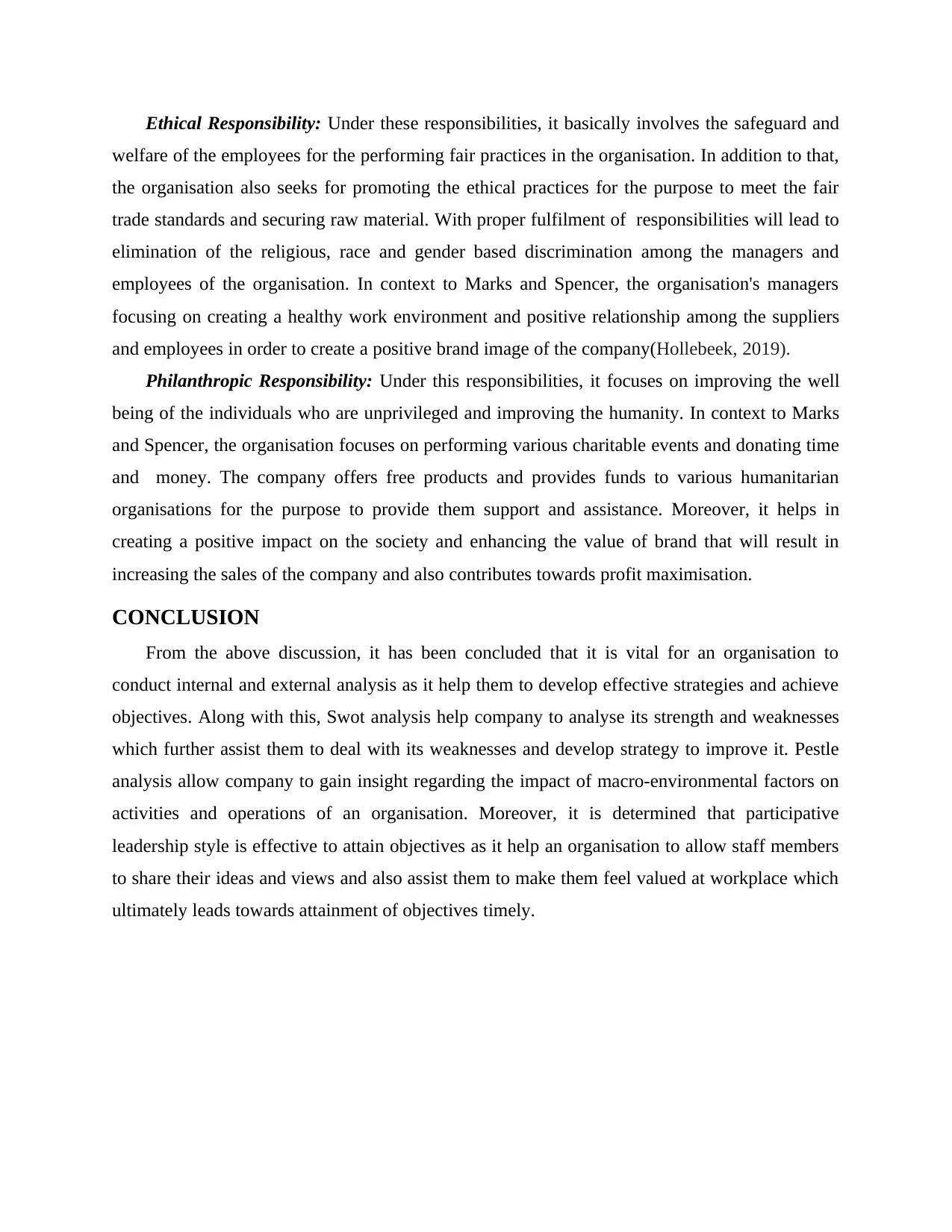
Ethical Responsibility: Under these responsibilities, it basically involves the safeguard and
welfare of the employees for the performing fair practices in the organisation. In addition to that,
the organisation also seeks for promoting the ethical practices for the purpose to meet the fair
trade standards and securing raw material. With proper fulfilment of responsibilities will lead to
elimination of the religious, race and gender based discrimination among the managers and
employees of the organisation. In context to Marks and Spencer, the organisation's managers
focusing on creating a healthy work environment and positive relationship among the suppliers
and employees in order to create a positive brand image of the company(Hollebeek, 2019).
Philanthropic Responsibility: Under this responsibilities, it focuses on improving the well
being of the individuals who are unprivileged and improving the humanity. In context to Marks
and Spencer, the organisation focuses on performing various charitable events and donating time
and money. The company offers free products and provides funds to various humanitarian
organisations for the purpose to provide them support and assistance. Moreover, it helps in
creating a positive impact on the society and enhancing the value of brand that will result in
increasing the sales of the company and also contributes towards profit maximisation.
CONCLUSION
From the above discussion, it has been concluded that it is vital for an organisation to
conduct internal and external analysis as it help them to develop effective strategies and achieve
objectives. Along with this, Swot analysis help company to analyse its strength and weaknesses
which further assist them to deal with its weaknesses and develop strategy to improve it. Pestle
analysis allow company to gain insight regarding the impact of macro-environmental factors on
activities and operations of an organisation. Moreover, it is determined that participative
leadership style is effective to attain objectives as it help an organisation to allow staff members
to share their ideas and views and also assist them to make them feel valued at workplace which
ultimately leads towards attainment of objectives timely.
welfare of the employees for the performing fair practices in the organisation. In addition to that,
the organisation also seeks for promoting the ethical practices for the purpose to meet the fair
trade standards and securing raw material. With proper fulfilment of responsibilities will lead to
elimination of the religious, race and gender based discrimination among the managers and
employees of the organisation. In context to Marks and Spencer, the organisation's managers
focusing on creating a healthy work environment and positive relationship among the suppliers
and employees in order to create a positive brand image of the company(Hollebeek, 2019).
Philanthropic Responsibility: Under this responsibilities, it focuses on improving the well
being of the individuals who are unprivileged and improving the humanity. In context to Marks
and Spencer, the organisation focuses on performing various charitable events and donating time
and money. The company offers free products and provides funds to various humanitarian
organisations for the purpose to provide them support and assistance. Moreover, it helps in
creating a positive impact on the society and enhancing the value of brand that will result in
increasing the sales of the company and also contributes towards profit maximisation.
CONCLUSION
From the above discussion, it has been concluded that it is vital for an organisation to
conduct internal and external analysis as it help them to develop effective strategies and achieve
objectives. Along with this, Swot analysis help company to analyse its strength and weaknesses
which further assist them to deal with its weaknesses and develop strategy to improve it. Pestle
analysis allow company to gain insight regarding the impact of macro-environmental factors on
activities and operations of an organisation. Moreover, it is determined that participative
leadership style is effective to attain objectives as it help an organisation to allow staff members
to share their ideas and views and also assist them to make them feel valued at workplace which
ultimately leads towards attainment of objectives timely.
Paraphrase This Document
Need a fresh take? Get an instant paraphrase of this document with our AI Paraphraser
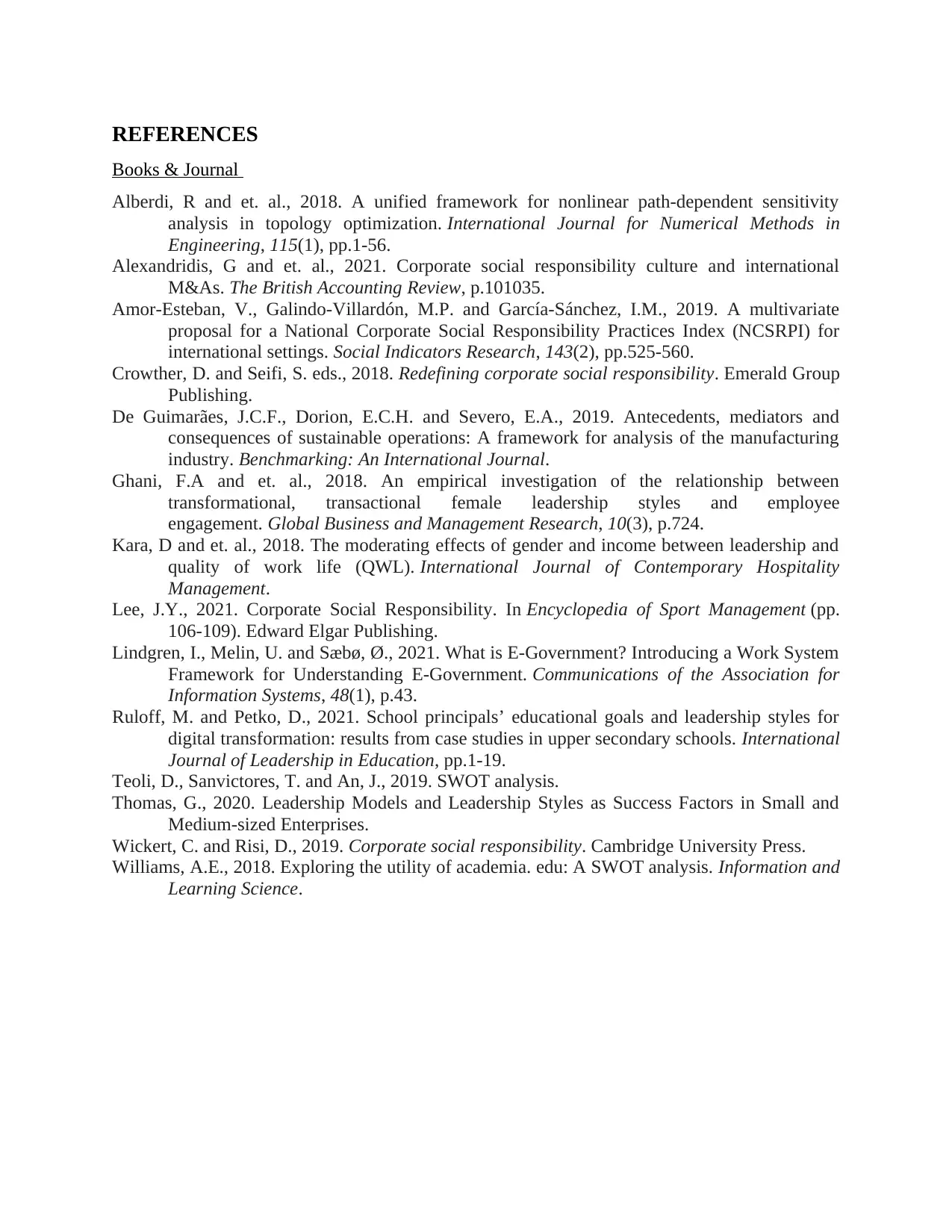
REFERENCES
Books & Journal
Alberdi, R and et. al., 2018. A unified framework for nonlinear path‐dependent sensitivity
analysis in topology optimization. International Journal for Numerical Methods in
Engineering, 115(1), pp.1-56.
Alexandridis, G and et. al., 2021. Corporate social responsibility culture and international
M&As. The British Accounting Review, p.101035.
Amor-Esteban, V., Galindo-Villardón, M.P. and García-Sánchez, I.M., 2019. A multivariate
proposal for a National Corporate Social Responsibility Practices Index (NCSRPI) for
international settings. Social Indicators Research, 143(2), pp.525-560.
Crowther, D. and Seifi, S. eds., 2018. Redefining corporate social responsibility. Emerald Group
Publishing.
De Guimarães, J.C.F., Dorion, E.C.H. and Severo, E.A., 2019. Antecedents, mediators and
consequences of sustainable operations: A framework for analysis of the manufacturing
industry. Benchmarking: An International Journal.
Ghani, F.A and et. al., 2018. An empirical investigation of the relationship between
transformational, transactional female leadership styles and employee
engagement. Global Business and Management Research, 10(3), p.724.
Kara, D and et. al., 2018. The moderating effects of gender and income between leadership and
quality of work life (QWL). International Journal of Contemporary Hospitality
Management.
Lee, J.Y., 2021. Corporate Social Responsibility. In Encyclopedia of Sport Management (pp.
106-109). Edward Elgar Publishing.
Lindgren, I., Melin, U. and Sæbø, Ø., 2021. What is E-Government? Introducing a Work System
Framework for Understanding E-Government. Communications of the Association for
Information Systems, 48(1), p.43.
Ruloff, M. and Petko, D., 2021. School principals’ educational goals and leadership styles for
digital transformation: results from case studies in upper secondary schools. International
Journal of Leadership in Education, pp.1-19.
Teoli, D., Sanvictores, T. and An, J., 2019. SWOT analysis.
Thomas, G., 2020. Leadership Models and Leadership Styles as Success Factors in Small and
Medium-sized Enterprises.
Wickert, C. and Risi, D., 2019. Corporate social responsibility. Cambridge University Press.
Williams, A.E., 2018. Exploring the utility of academia. edu: A SWOT analysis. Information and
Learning Science.
Books & Journal
Alberdi, R and et. al., 2018. A unified framework for nonlinear path‐dependent sensitivity
analysis in topology optimization. International Journal for Numerical Methods in
Engineering, 115(1), pp.1-56.
Alexandridis, G and et. al., 2021. Corporate social responsibility culture and international
M&As. The British Accounting Review, p.101035.
Amor-Esteban, V., Galindo-Villardón, M.P. and García-Sánchez, I.M., 2019. A multivariate
proposal for a National Corporate Social Responsibility Practices Index (NCSRPI) for
international settings. Social Indicators Research, 143(2), pp.525-560.
Crowther, D. and Seifi, S. eds., 2018. Redefining corporate social responsibility. Emerald Group
Publishing.
De Guimarães, J.C.F., Dorion, E.C.H. and Severo, E.A., 2019. Antecedents, mediators and
consequences of sustainable operations: A framework for analysis of the manufacturing
industry. Benchmarking: An International Journal.
Ghani, F.A and et. al., 2018. An empirical investigation of the relationship between
transformational, transactional female leadership styles and employee
engagement. Global Business and Management Research, 10(3), p.724.
Kara, D and et. al., 2018. The moderating effects of gender and income between leadership and
quality of work life (QWL). International Journal of Contemporary Hospitality
Management.
Lee, J.Y., 2021. Corporate Social Responsibility. In Encyclopedia of Sport Management (pp.
106-109). Edward Elgar Publishing.
Lindgren, I., Melin, U. and Sæbø, Ø., 2021. What is E-Government? Introducing a Work System
Framework for Understanding E-Government. Communications of the Association for
Information Systems, 48(1), p.43.
Ruloff, M. and Petko, D., 2021. School principals’ educational goals and leadership styles for
digital transformation: results from case studies in upper secondary schools. International
Journal of Leadership in Education, pp.1-19.
Teoli, D., Sanvictores, T. and An, J., 2019. SWOT analysis.
Thomas, G., 2020. Leadership Models and Leadership Styles as Success Factors in Small and
Medium-sized Enterprises.
Wickert, C. and Risi, D., 2019. Corporate social responsibility. Cambridge University Press.
Williams, A.E., 2018. Exploring the utility of academia. edu: A SWOT analysis. Information and
Learning Science.
1 out of 11
Related Documents
Your All-in-One AI-Powered Toolkit for Academic Success.
+13062052269
info@desklib.com
Available 24*7 on WhatsApp / Email
![[object Object]](/_next/static/media/star-bottom.7253800d.svg)
Unlock your academic potential
Copyright © 2020–2025 A2Z Services. All Rights Reserved. Developed and managed by ZUCOL.


